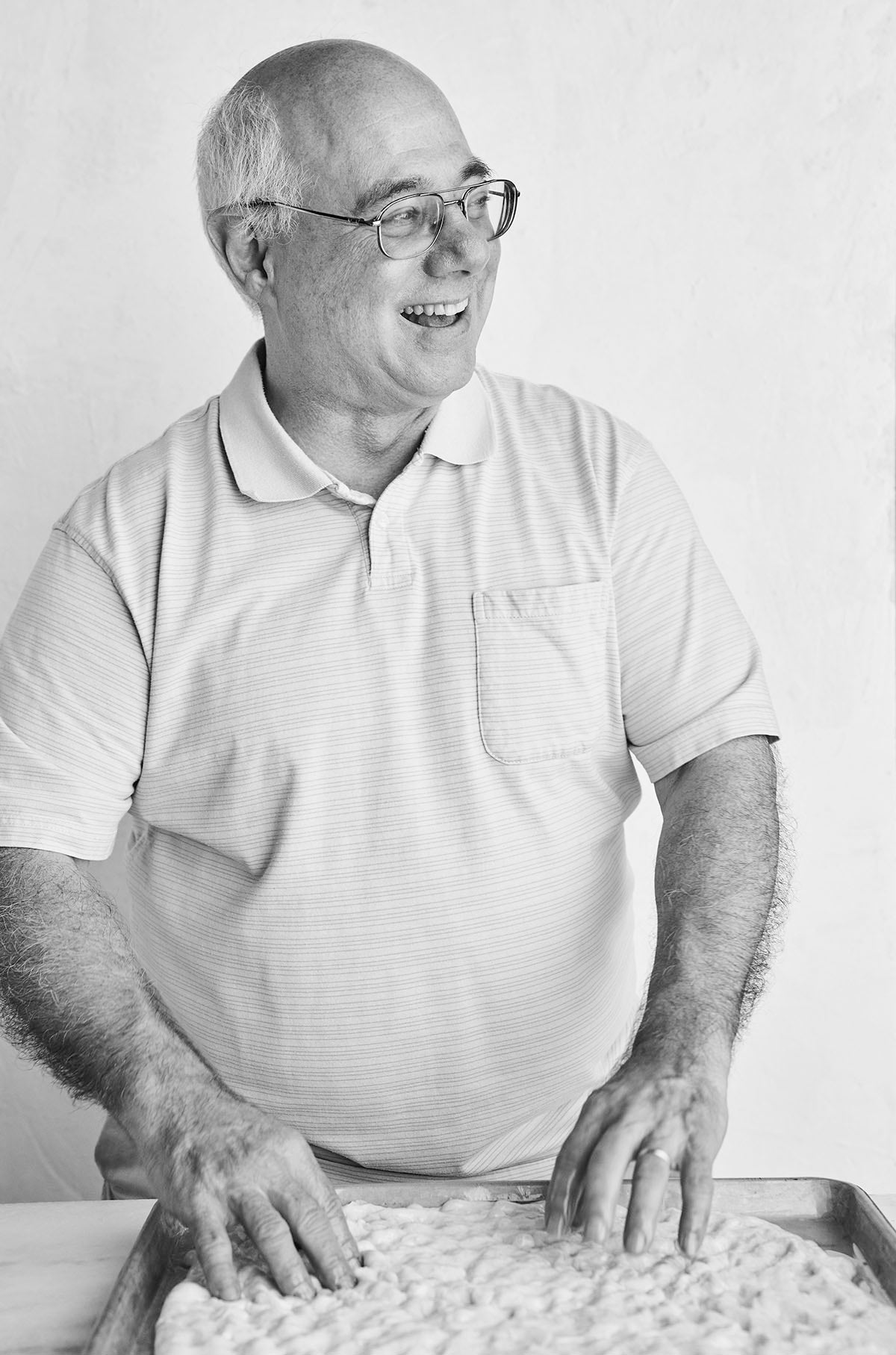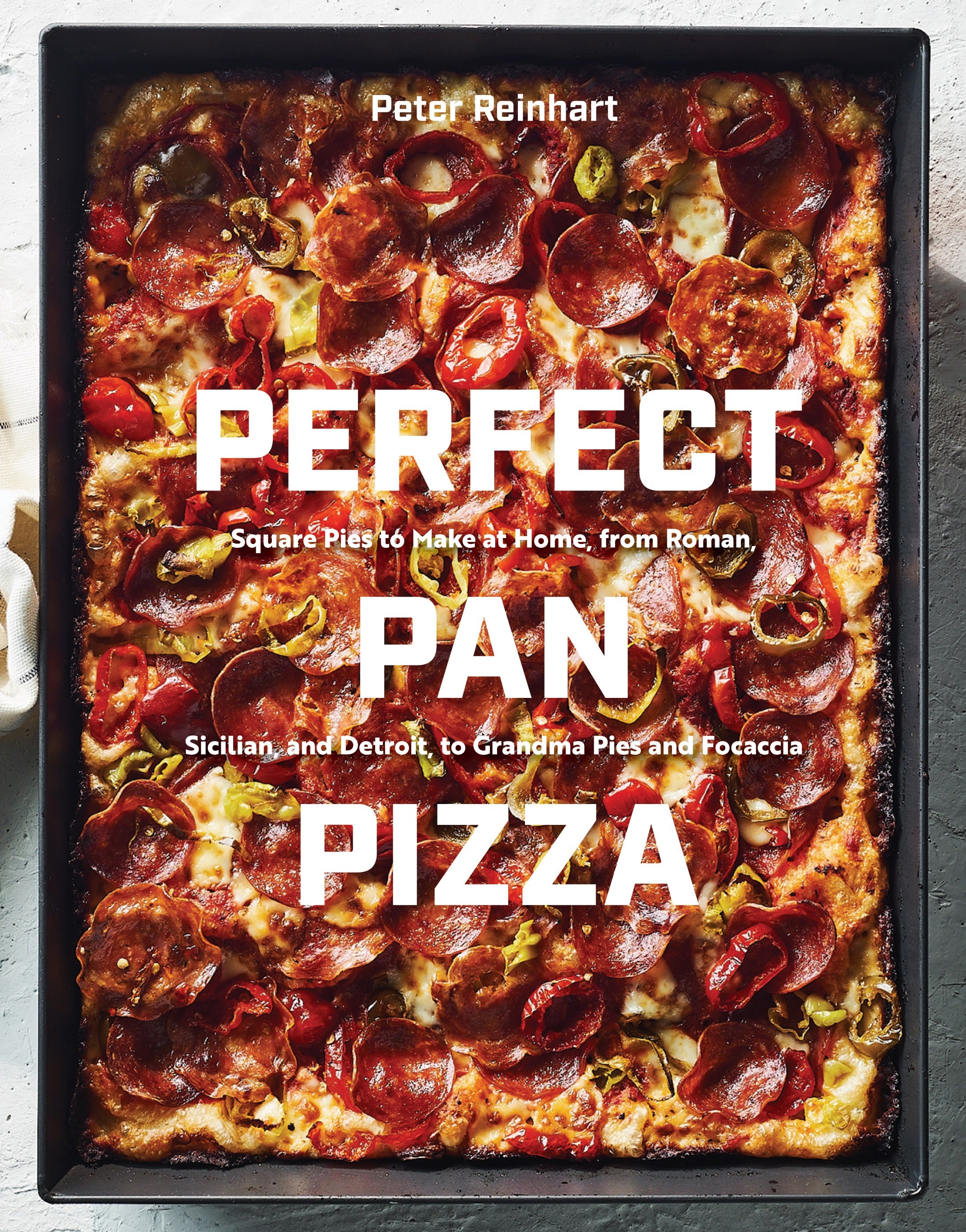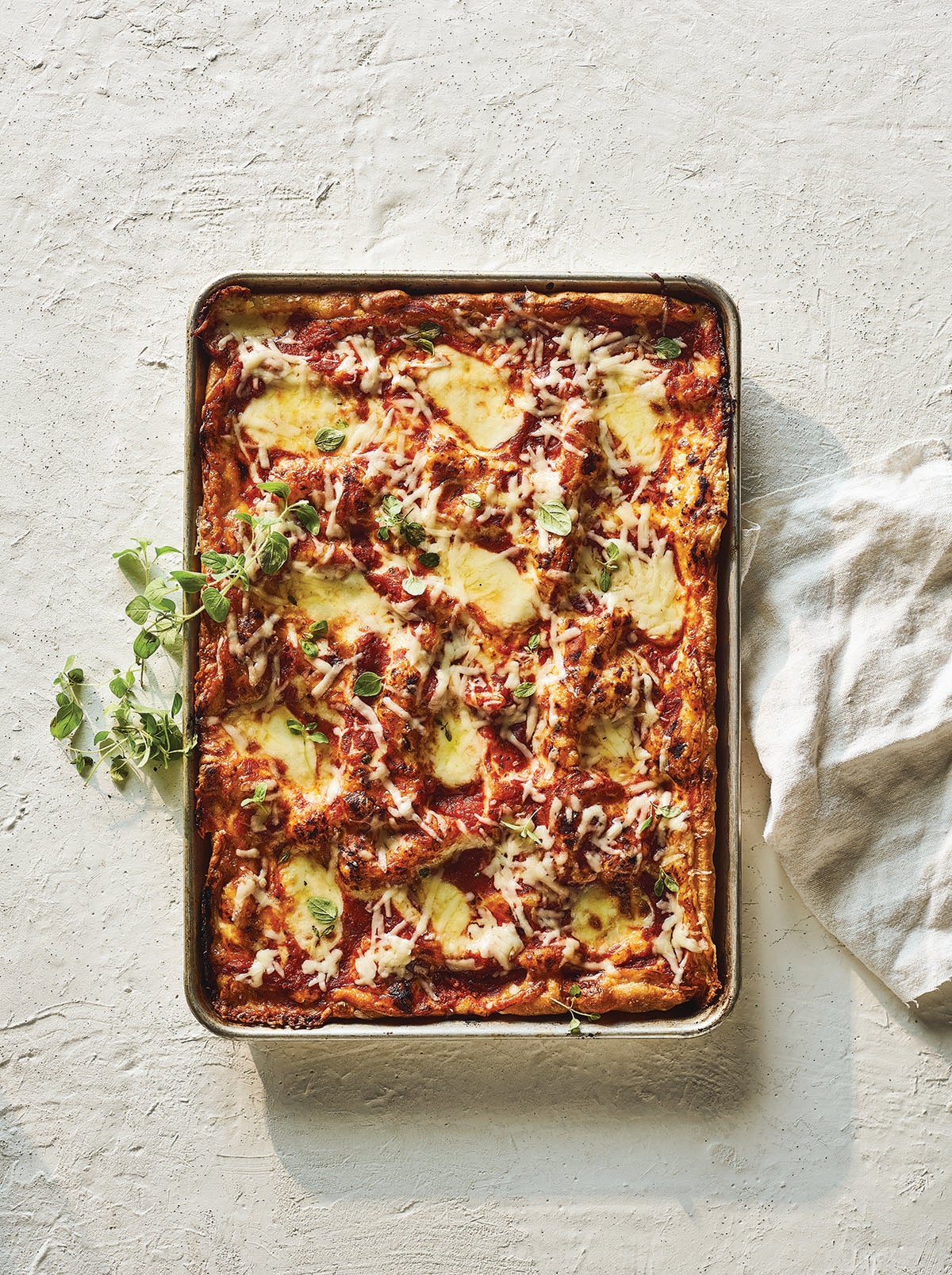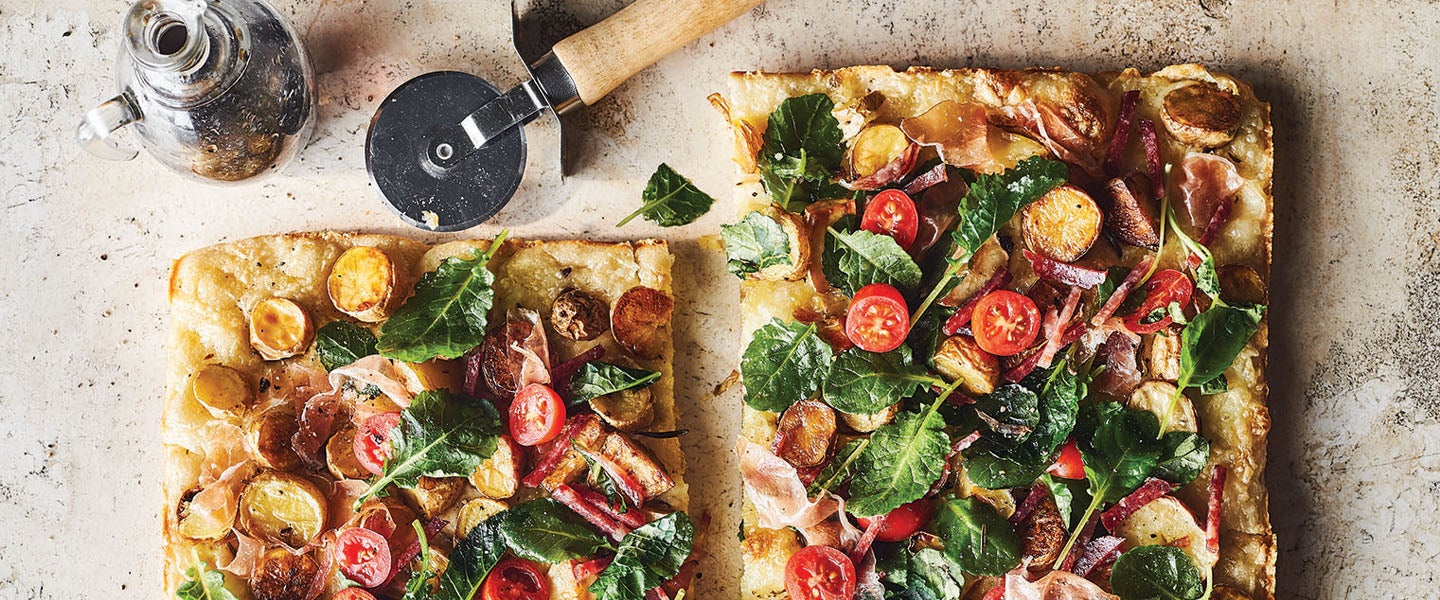Odds are, if you’re eating a hunk of delicious, crusty bread in the U.S., Peter Reinhart had something to do with it. Perhaps literally, if you’ve found yourself in the presence of the renowned bread teacher in the flesh, but mostly figuratively.
Reinhart has been instrumental in shaping American bread culture since the 1980s, and you could argue he’s one of the most famous cheerleaders of this staple food. He wrote the chapter on breadmaking for the 1997 revision of the legendary cookbook The Joy of Cooking. He’s won James Beard Awards for his solo books and taken medals at bread contests. He influenced multiple generations of bakers as an instructor at the prestigious Johnson & Wales culinary arts program. He’s consulted for major brands, creating a line of frozen foods for Amy’s Kitchen and brainstorming with Kraft, Frito Lay and other major companies. He’s even given a TED Talk about the alchemy of flour, water, yeast and salt.
In short, Reinhart is an influential force who remains obsessed as ever with the doughy stuff, nearly five decades after he first worked with bread as a film-school dropout looking for a part-time hustle. Lately, his muse has been pizza, but not the thin, Neapolitan-style pies that he experimented with in the past. Instead, it’s the pan pizza — the thick, gregarious cousin to the crisp thin-crust pizzas that have been championed from NYC to L.A. — that has captured his attention. There have always been regional love affairs with pan pizza — Chicago has the deep-dish, the Northeast has Sicilian and “Grandma” pies, Detroit has, er, the Detroit-style. But lately, Reinhart has been seeing more and more signs that pan pizza is hitting the mainstream in a big way.

“I’ve been going to these big industry pizza expos for a long time, and I’ve been tracking the emergence of the cheesy, crisp Detroit-style pizza over the last couple of years. And recently, on the heels of that little trend, there was a boom in Roman-style pizzas that are baked in big sheets. It felt like a tsunami about to come ashore,” Reinhart tells me.
Then, in a stroke of destiny, he got a call from a restaurant owner in Frisco, Texas. The owner had tasted a Detroit-style pie that blew his mind in Telluride, Colorado, and he wanted to build a recipe from scratch that replicated the idea in his head. Could he fly Reinhart to North Texas for a week of experimentation? Reinhart, piqued by the promise of a challenge, agreed to meet. After six days of work, the duo and the kitchen team sat back and marveled at their final creation. “I looked at the team, and I just blurted out, ‘This is amazing. I love this.’ I wasn’t expecting this pizza would jump to the top of my must-try pantheon, but we hit all the check marks we wanted. A buttery undercrust with a toffee-like shatter. This crispy, cheesy edge all along the outside. A dough that, even though it looked far more bready than I usually like for a pizza, was creamy and custardy,” Reinhart recalls. “It was heaven in a bite. Months later I got a call that the restaurant, Mash’d, couldn’t keep up with the orders from the dining room.”
That week sparked a love affair with a type of pizza Reinhart had been largely ambivalent about, and propelled him on the path to research and write Perfect Pan Pizza, his new cookbook. As he ate and documented his observations on each regional style, he began to form a sort of unified theory of pan pizza. At its heart is a dough more like focaccia bread than a typical pizza dough. Simple modifications to flour and technique lead to the different regional expressions. “It’s essentially a master formula. We have three main doughs in the book, but they’re variations on a theme. I wanted to create a recipe at a level people aren’t used to having, certainly at home but even in pizzerias. That was the challenge,” he says.

I recently spoke to Reinhart about his pan pizza recipes and the long career that led him to this moment. While he clearly loves all things pizza, it ended up being a two-hour conversation about flour, spirituality, corporate food manufacturing practices and how American bread finally became great again.
You’ve already experimented and written about pizza before. Some people call your Neapolitan dough formula “the best ever.” Why chase this romance with the pan style?
When I wrote American Pie, I searched for the perfect pizza 15 years ago. While everyone loves pizza, not that many people at home make them, historically speaking, and the sales at the time reflected that. But in the last couple of years, that’s begun to change. The experts are starting to add their voice to the conversation in this way — Tony Gemignani, who’s a champion pizzamaker, did The Pizza Bible. The godfather of modern Roman pizza, Gabriele Bonci, has a terrific book. So it felt like time.
We think of pizza as the classic Neapolitan-inspired round, but in Italy, there’s different names for pizza all around the country. Focaccia is the pizza of Northern Italy. Schiacciata is the pizza of Tuscany. Sfincione is Sicily. And all of those original styles began to change when they arrived in America. Some people say a Sicilian is twice-baked, whereas the similar-looking Grandma is single-baked. Then you’ll look in another book, and it’ll say the exact opposite. So we end up with a sort of blank canvas, and the goal was to just build pizzas that have a philosophy but are doable at home and easy to love. A lot of the ideas, I just picked up at the pizza expos, which is a smorgasbord of options. I got to be a pizza competition judge, and it’s illuminating to see how all these pros approach the same basic dish so differently.
You highlight a range of different flavor combinations, ranging from a traditional plain Grandma pie to one loaded up with pepperoni and peppers and many, many more. Did you ever settle on a favorite?
I think that number one is the “red stripe,” what’s known as sort of the classic, Detroit-style pizza. It has an origin story, at Buddy’s Pizza Bar. I like the concept. It’s a simple pizza with lots of cheese but not that much sauce. It’s got two stripes of sauce going down the thing, either put on before or after cooking, and it’s sort of supposed to evoke the idea of Motor City — like the tracks are tire marks for someone peeling out of the parking lot. Pizza can really connect to a place with little ideas like that. But I also just like the concept of putting sauce on after the pizza comes out of the oven, because of how fresh and vibrant the sauce stays. It’s another contrasting burst of flavor that you don’t get in normal pizza.
It sounds like pan pizzas, in their versatility and how they’ve morphed from their origins, are a prototypically American thing.
That’s a good insight. I mean, you could really argue that America is the center of the pizza-eating universe. Even though we didn’t invent it… well, the Italians didn’t invent it either. But when the pizza hit these shores, it landed in some fertile soil. People were comfortable asking the question of how far we could push the limits on what pizza is. I think we’re influencing other countries’ pizza today just as much as anyone else influenced ours, if not more.
Did you know from early on that making and baking bread was going to be your life’s work?
No. I dropped out of Boston University because I was a film and journalism major but had some job offers to get into the film business. I wasn’t too happy, anyway, in college. I just felt like I wasn’t getting that much value out of it. I guess I was on, like a lot of college students, a personal journey of self-discovery, trying to find out who I am and what it is that I’m supposed to be doing with my life. And back in the late 1960s, there were a lot of what I’d call seekers. You know, people who were seeking the truth and turning away from whatever religion they were brought up in and considering other options.
I found this group of young people who were mulling the same things as me, and as it turned out, they were opening a little vegetarian restaurant, something unlike anything on the East Coast. It was very Californian. I never considering cooking as a career path, but I just fell in love with this group of people and the work they wanted to do. We had to teach ourselves recipes out of The Joy of Cooking, figuring it out as we went along. But after a few months, I discovered an aptitude for the kitchen. I was starting to make original dishes.
I was just 21 years old then, and decided to continue at the restaurant for a few years. During that time, I discovered a Christian community that pulled together these teachings I got into because of my interest in Eastern philosophies and religions. I started going to this group’s classes. Some of the people from the restaurant got involved. It basically grew into us deciding to create a lay community around the teachings of the group, which was called the Holy Order of MANS and started in San Francisco.
Is that how you ended up across the country? Your breadmaking career is defined by a lot of things that happened in Northern California.
Yeah, San Francisco was the headquarters for the group. It started in the 1960s as an eclectic independent Christian group that had a little bit of everything: Eastern traditions, Jesuit and Franciscan trappings, Rosicrucianism… It really was something that could only probably exist in the 1960s, hah. But it grew because it touched a nerve with those who couldn’t find answers in the ideas they already knew. The key insight was that everything was service-oriented: The fastest way to know God is to serve somebody else. On the basis of that one insight, I joined as a full-time member and threw in for the next 20 years. We did missionary work, service work, here and there. And everywhere I went, I found myself in the kitchen.
Eventually, we ended up getting transferred to San Francisco. There was already great bread there, but when I ended up in the main seminary’s kitchen, I decided to make bread for fun, using a recipe for baguettes from a Julia Child book that a friend showed me. It was about seven pages of very elaborate instructions, but somehow, it worked perfectly. It was as good as anything I could buy in San Francisco. That got me going.
Let’s fast-forward to when you decided to open a café and then a full bakery in Sonoma County. Brother Juniper’s Bakery is still a legendary name for people who ate your bread back in the 1990s. How did you transition from seminary life to this?
I ended up working at our second headquarters in Sonoma, doing a lot of writing and working on our theological journal as lead editor. We were continuing to explore where we were headed as a Christian community. While I was doing that, I was making bread on the side and discovered a version called struan, a traditional Celtic bread. It’s associated with the harvest festival, and we did it to celebrate Michaelmas. There’s no real recipe for it, which was fine by me, because that meant I could fuss with it.
So the first year’s bread was good, not extraordinary. By year three, I was starting to zero in on the right balance. Over those years, I’d gotten married to another member of the community. My wife was a really good cook, so we decided to open a little restaurant in Forestville, California, just to create some jobs for people and give back while also having a space to test our food ideas. It’s where I nailed the struan. Looking back, it’s the best bread I ever made. It’s still my favorite. It made the best toast you’ll ever eat. Before long, the wine country chefs found us and started making requests. We decided to open Brother Juniper’s because of that.

It sounds too good to be true. Why isn’t it open today?
Well, Brother Juniper’s started with about 20 loaves a day. By the time it was at full production, we were making 2,000 loaves a day. Early on, I wrote Brother Juniper’s Bread Book, and it got us a following. All of a sudden, the New York Times showed up wanting to write about us. But to be honest, after some time, my wife and I realized we didn’t want to be business owners forever. That wasn’t our mission in life. Neither of us were business-minded, and the operation started to become a burden. So after a decade, we sold it to some like-minded folks and said goodbye. By that time, I’d written more books and gotten an offer to teach. That was 30 years ago, and I’ve been teaching ever since.
You’ve been at the forefront of seeing American bread culture develop, with a “craft bakery” trend starting to take hold in many major cities. Will the artisanal, handmade product ever replace the Big Bread supermarket brands?
There’s always been a kind of a disconnect between the artisan community and the mainstream community, mainly because of suspicion on both sides. The artisans have been a bit snobby about saying, basically, “You big companies are making just shit bread.” And the big companies have basically replied, “Screw you.” It took years and years to bridge that gap. Now, when you go to a big convention like the Baking Expo in Las Vegas, everybody comes and communicates. The Bread Bakers Guild of America and the artisans do presentations, and the volume bakers and the guys who make chemical additives make presentations. There’s more crossover because what’s happening in the craft beer space is happening to small bakeries, too. There were hundreds of small brewers in America 150 years ago, and they were either bought by Anheuser-Busch and a few big companies, or they were put out of business. Once again, we see big companies buying up small ones and consolidating them.
The famous baker Nancy Silverton is a good example right there in L.A. She built La Brea Bakery up from a little corner shop and then sold it, at which point it became one of the largest bread makers in the world. Now, the craft, artisanal side of baking has greatly impacted the mass-produced side, to where the public perception of what’s acceptable has changed. People really want better beer, and they want better bread. So La Brea is making a ton of bread and a lot of people are buying it, and they don’t need to know Nancy Silverton’s whole backstory. They just know it’s pretty good, because even if it’s a big production, it follows the principles of artisan bread, of proper fermentation, which is where it starts.
It almost sounds like even “commercial” bread in this country has a chance to keep getting better and better to the point where it’s almost artisan level.
I mean, to a degree. Take, for instance, Chad Robertson of Tartine Bakery. I knew Chad when he was just a little start-up baker in Point Reyes, California. And we watched him grow and become this mega-star in the bread world, putting out wonderful books and pushing boundaries. Two years ago, at our bread symposium at Johnson & Wales, he was the poster boy for the future of artisan breads. So what’s his next step? He says he’s trying to master the concept of craft at scale. He wants to be able to produce breads to feed a lot more people at that same level of quality, so that more people can experience what excellence in bread can be. He’s trying to do what Nancy did with La Brea, but take it to the next level.
Bread making is just one symbol of all of the changes that are going on in this crazy world right now. But it’s also a symbol of hope, because it’s showing that quality, excellence and craft all can exist in a time of mass industrialization and fear and everything else.
Is it satisfying to see a sort of legacy to the work you cared so much about 40 years ago?
I didn’t set out to be a bread maker. I didn’t even set out to become a person of faith. But what I found in the bread community is a lot of people like me who didn’t dream of bread, but just kind of found bread, and bread found them. I guess what I’m trying to say is, they are my life’s work. Bread and my beliefs go together. The deeper I go into bread making, the more it affirms my spiritual intuition of what life is all about, what the purpose of life is and the creative force that drives everything. It’s the joy of working to create something beautiful and dig into the layers of that work. I just see it reflected everywhere in bread.

